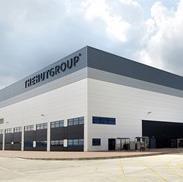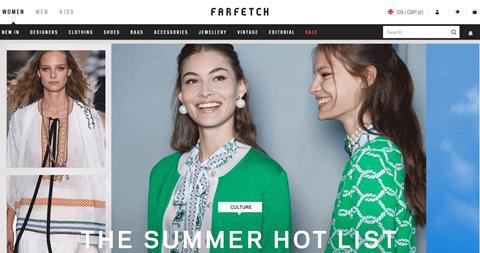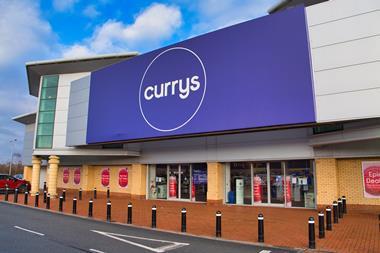Amazon, Ocado, Farfetch and The Hut Group are just some of the retailers that have branched out into selling the technology that they build in-house, and their tech divisions are the fastest-growing – and often highest valued – part of the business.
Amazon’s tech platform is the most profitable part of its business, accounting for almost 60% of operating profits last year, while Ocado’s share price has surged more than 200% since the beginning of 2018 on the back of a string of technology deals.
We look at the retailers that have become tech titans, how they have done it, and what makes them distinct.
Amazon
Amazon, as ever, was a trailblazer in this area, launching Amazon Web Services (AWS) in 2006. Last year, almost 60% of the online giant’s operating profit – a whopping $7.3bn – came from AWS, which grew an impressive 47% over the year.

However, the retailer originally developed the cloud-based platform back in the early 2000s as it was frustrated that searching for suitable storage and database solutions was delaying development projects internally.
AWS senior consultant, global advisory, Mario Thomas explains: “Product development leaders would regularly report that for a project that should take two to three months end to end, they were spending two to three months just on the storage solution or on the database solution or on how they were going to handle hosting – and that multiple different teams were doing the same thing.
“None of what they were building on the infrastructure side would scale beyond their own project and they were all reinventing the wheel.”
Thomas says there was a “real thirst” internally for scalable, reliable infrastructure services so it looked to build it itself. “Even if we never built AWS to be used by external customers, we were going to build those services to allow Amazon, the retailer, to move more quickly,” says Thomas.
However, Amazon boss Jeff Bezos knew AWS had the potential to be a large part of Amazon so invested in a dedicated team to build the business.
Today, AWS works with millions of customers across the world, including more than 100,000 UK customers. Among the ranks of those customers are River Island, Ao.com, Ocado and Sainsbury’s grocery business.
“The AWS Cloud frees up companies to focus on what really differentiates their organisations and leaves the undifferentiated heavy lifting of the underlying technology infrastructure to AWS”
Mario Thomas, AWS
But what does AWS offer those business?
Thomas says: “The AWS Cloud frees up companies to focus on what really differentiates their organisations and leaves the undifferentiated heavy lifting of the underlying technology infrastructure to AWS.”
Thomas says AWS stands out from other platform providers as it is innovating faster than them.
“In a space that’s moving as fast as the cloud is, to be partnered with the company that has the most functionality, that’s iterating the quickest, has the largest community, had the vision for cloud from the start without having to patch together acquisitions,” he says.
In 2018, Amazon released 1,957 new significant services and features, compared with 80 in 2011.
It is particularly far ahead in new areas such as machine learning, AI, Internet of Things and serverless computing, insists Thomas.
“AWS has more services, and more features within those services, than any other cloud provider – by a large amount.”
Ocado
Ocado may trade on AWS but it has used that infrastructure to power its own Smart Platform for online groceries.

The retailer built almost all of the technology that powers its ecommerce, fulfilment and logistics platform before outsourcing that package to other retailers.
Ocado Technology chief operating officer Anne-Marie Neatham says its technology allows retailers to do online grocery “scalably, sustainably, and profitably” for the first time.
“Grocery is the most difficult retail segment to deliver online profitably due to huge complexity from large shopping baskets averaging at around 50 items, varying temperature regimes (ambient, chilled and frozen), short shelflife of products, low tolerance for substitutions, high expectations for on-time delivery and razor-thin margins.”
Neatham says it was difficult for Ocado to get the market to understand that it was not just another grocer but one with technology at its heart: “We have been able to deliver orders at a profit for many years. We chose to plough that profit back into the creation of technology in order to continue to improve our offering and to disrupt the current market. This was not an easy message to deliver to the market.”
That message has been well and truly delivered.
Ocado’s share price has surged more than 200% since the beginning of 2018 after it inked deals with Kroger in the US, Sobeys in Canada, ICA in Sweden, Coles in Australia and M&S.
Tech. 2019
Book your ticket to Tech, our two-day festival of digital commerce and the technology driving it. Speakers include:

- Amir Kabbara, product and engineering leader, Amazon
- Sara Wood, EVP, Farfetch
- Brad Klingenberg, chief algorithms officer, Stitch Fix
- Josh Builder, CTO and head of product, Rent The Runway
- Toussaint Wattinne, general manager, UK and Ireland, Uber Eats
To find out more visit: www.tech-festival.com
The Hut Group
The Hut Group (THG) has been trading on its proprietary technology platform, Ingenuity, since 2005. Like Amazon, THG developed the platform as a response to what co-founder and executive chair Matt Moulding describes as “the expensive and poorly performing outsourced solutions” available at that time.

“We saw a distinct lack of any technical solution that provided a genuine end-to-end solution which was cost effective. On the face of it, entry-level products are considered cost effective but tend to be gateways to expensive add-ons if clients want a full service,” says Moulding.
“We were aware of the amount of money scaled digital businesses were spending on technology and identified an opportunity to unlock substantial shareholder value by removing expensive add-ons and creating one end-to-end service.”
Now brands including Nestlé, Honda, Daily Mail and P&G trade on the platform.
Moulding says it is its “end-to-end” service that sets it apart. It has integrated features such as 46 local languages, 30 payment methods and more than 30 direct international courier integrations. THG can also extend its service to include digital marketing and brand management.
THG has ploughed “hundreds of millions of pounds” into its Ingenuity platform over the past 15 years, according to Moulding, and has made numerous acquisitions to bolster its capabilities. These include digital content agency Hangar Seven, web-hosting business UK2 and translations provider Language Connect.
The majority of THG employees – more than 600 people – now work on the technology side of the business.
Farfetch
Unlike the rest of the businesses listed, Farfetch started out as a tech company.
Farfetch was built as a tech marketplace to enable boutiques to sell their wares to a global audience; however, in 2015 it launched Farfetch Black & White – now Farfetch Platform Solutions , a white-label ecommerce solution for brands and retailers on its platform.

With Farfetch, luxury brands can choose to simply sell on Farfetch’s retail platform or opt to take advantage of its ecommerce excellence and have the firm build and manage their branded website.
The white-label solutions are built on Farfetch’s platform, and provide brands with the same capabilities and scale as Farfetch’s own website. This means brands benefit from all the improvements to and innovations on Farfetch’s website.
Farfetch offers a “modular package” of solutions so retailers can choose from specific bundles of products and services, or they can sign up to a full end-to-end solution.
On the front end, Farfetch offers global websites, apps or WeChat stores, and on the back end, its infrastructure allows retailers and brands to synchronise their websites with in-store and warehouse inventory.
It now operates the websites of 17 luxury fashion retailers, including JW Anderson, Thom Brown and AMI Paris.
Farfetch’s roots were in giving luxury boutiques a global audience, but it has started to work with bigger retailers. In February this year it partnered with Harrods to launch the department store’s global website on its platform. The partnership spans ecommerce management, operations, international logistics and technology.
The firm also has a Store of the Future division, which works with retailers including Chanel to bring technology to the store environment.
The firm’s expertise in China, a notoriously difficult ecommerce market for western retailers to crack, is a USP, says Farfech Platform Solutions executive vice-president Kelly Kowal. It acquired CuriosityChina, a digital and technology business that focuses on amplifying luxury brands across China’s digital platforms.
“We offer an end-to-end solution for China including cross-border logistics, localised payments and an integrated global tech architecture. We have launched fully localised versions of our partner sites in China, including JW Anderson, Thom Browne and AMI Paris,” says Kowal.
Investors were taken by the tech firm and despite still being loss-making, it made its debut on New York Stock Exchange last September with a $6.2bn valuation. However, less than a year later its market cap has plunged to little more than $3bn after it posted wider than expected losses and spent a sizeable $675m on fashion group New Guards, which owns streetwear sensation Off-White.


























No comments yet